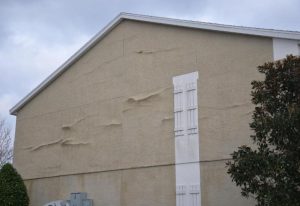Noble Public Adjusting Group is on a mission to educate policyholders about insurance and the pitfalls some of the language can find you facing. Today we are reaching out to Florida condo association members. If the condos in your community were built with stucco, especially during the Florida building boom of 2005-2010, and condo owners are having problems with water leaks, cracks, or other damage to the structure of their condos, under the right circumstances you could find every condo in your community being completely refurbished and have it paid for by insurance proceeds as a result of “concurrent causation.”
This may sound far-fetched, but let us explain, and we will try to do so in simple language that is not too confusing. Not to say condo association members are not intelligent, but just researching the facts for this article made Noble realize that the language involved in explaining this issue is quite involved.
Florida Condo Associations: Faulty Stucco Installation and Concurrent Causation
If the condo owners in your community are complaining of water leaks after a storm, or cracks in the structure of their condos, what may be discovered by a professional inspection is that there was negligence in the original stucco installation. This article from USA Today has this to say about the problem, “Engineers say massive stucco failures in Florida homes, many just five-to-seven years old, can be directly connected to negligence in the installation process.”

This is not something that just came to light. The stucco issue created national headlines with the case of Florida homeowner John Sebo. This article from the construction and real estate law blog of JD Supra sums up what happened to Mr. Sebo and the courts ruling in his favor, “The Florida Supreme Court recently issued a widely reported decision, Sebo v. American Home Assurance Co., which applied the concurrent cause doctrine in ruling that an all-risk homeowner’s insurance policy provides coverage when damage is the result of multiple events—so long as at least one of them is a covered peril. Plaintiff John Sebo purchased a home, which he insured under an all-risk homeowner’s policy written by American Home. As an “all-risk” policy, it provided coverage for damage to property caused by all perils, except those it explicitly excluded. Design defects and faulty construction were among the excluded perils. Within less than two months of buying the house, Mr. Sebo discovered major leaks during rainstorms, which were later found to be the result of design defects and faulty construction. Hurricane Wilma then caused even more damage. When Mr. Sebo sought coverage for damage from the water intrusion, American Home denied most of the claim on the grounds that it was caused by design defects and faulty construction—which were excluded perils. But the Florida Supreme Court found coverage.”
In that excerpt, there is a great example of concurrent causation. When you as a policyholder experience damage that is a result of multiple events, even if one of them, such as a faulty stucco installation, is not covered, you can very well have your claim approved for both events under the concurrent causation rule. So if your condo association members are having condo owners report cracks, leaks, or other structural damage, and the condos are built with stucco, as we said in the beginning of this post, your community could find itself getting a lot of refurbished condos on the insurance company’s dime.
To help you understand this stucco issue as it affects condos in Florida even better, this article from the website of the FCAP, (Florida Community Association Professionals,) has this to say, “Is your association going to pay for “Florida’s billion-dollar stucco problem”? Here’s what you need to know in order to avoid being the next victim. Over the past few years, national home builders have made bad headlines throughout Florida from improperly installing stucco and then flatly denying home warranty claims. Florida homeowners continue to notice stucco cracks on their homes, condominiums, and particularly town homes. Most times damages are hidden by subtle water intrusion. However, what lies beneath is major property damage caused by cracks through walls and windows.” If you read the whole article, you will see how many lawsuits are currently in the courts relating to this stucco issue.
Noble Public Adjusting Group hopes that if you as a condo association member were not previously aware of this issue that you will pass along this article to your fellow condo association members, your condo community owners, and share it on your social media accounts. Condo association members and condo owners seriously need to be aware of what happened with bad stucco installation and how it can affect their home, along with the knowledge of how they can remedy the situation under concurrent causation.
As you can see, you are going to be very smart if you are having issues at your condo community with damages created by poor stucco installation if you use a public adjuster. Insurance companies are not going to sway easily when it comes to this stucco issue and concurrent causation, but we can handle the situation and most likely keep it from ever going to court. Noble will file the necessary insurance claims. We know how to get around denials from insurance companies and we may very well be able to have your association members see new condos due to concurrent causation.
Call us today if you have questions about stucco, damages to your condo, concurrent causation, or you are wanting to get started filing an insurance claim. Noble’s home office is in Panama City Beach, and we have several other offices in Florida, but we can handle insurance claims of all types and sizes anywhere in the US.
Noble Public Adjusting Group
107 Amar Place Suite 103
Panama City Beach (West End), FL 32413
(850) 249-MY-PA

